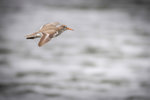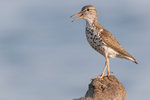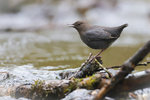


Until the pandemic, the Nisqually Land Trust provided annual raft trips down the Nisqually River each year in late July, when it’s sunny and warm and the river is still fairly high.
These trips offered a rare opportunity to see the undeveloped natural river corridor that the Land Trust is working to conserve. In fact, between the Land Trust, the Nisqually Tribe and other public agencies, nearly 80% of the river’s shoreline is permanently protected wildland.
On these trips, I serve as the resident naturalist for the people in my raft. From when we first enter the water until we take out, I am blabbing on and on about geology, water, plants – especially the big trees, -- and of course, all the birds. We see Bald Eagles, Ospreys, mergansers and waxwings and many more. Three species are especially interesting.
American Dipper
The American Dipper is not closely related to any other species. This bird has an amazing feeding method; it jumps into shallow water and walks along, probing for insect larvae and anything else edible. Sometimes it steals freshly spawned salmon and trout eggs. This bird is always along streams, both small and large. It is robin-sized and all gray, although its bill and feet look vaguely yellowish. Occasionally you will hear its burbling song as it flies.
Dippers are fairly common along the stream’s edge and have the habit of dipping, or bobbing, up and down. We always see a few along the Nisqually, but you can also find them along the Deschutes River at Tumwater Falls Park.
Dippers build a spherical nest of woven plant materials, especially mosses. I’ve seen them several times, hidden away in obscure locations.
Spotted Sandpiper
Just to confuse birdwatchers, there’s a totally unrelated bird species that also nests in river corridors that also likes to teeter up and down. The Spotted Sandpiper is one of two sandpiper-like birds that commonly breed in our county (the other is the Killdeer, a plover). These sandpipers nest along gravel bars, laying their clutch of four eggs in an open gravel location with a nest of a few woven grass stems. The eggs are mottled grey and black and are not easily seen because they look like small round rocks.
Although Spotted Sandpipers are about the size of the dipper (robin-sized), they look very different because they have longer legs and a pointed sandpiper bill. In their summer plumage, Spotted Sandpipers have a brownish back and dark spots on a white breast. When they fly, which they do when we’re rafting the river, they have an obvious white wing stripe. Newly hatched young are black with bright red legs. They look like round black ping-pong balls and are an amusing sight, especially when they hide under their mother’s wings – an adult bird with four sets of little red legs hiding under her extended wings.
Belted Kingfisher
Another bird we usually see along the river, the Belted Kingfisher, is also common in many water location in the county. Often you hear kingfishers before you see them, as they have a loud, raucous alarm call, often given in flight. Kingfishers seem to have territories along the river. When we encounter a pair, they seem to be escorting us along. But when we encounter a second pair, they chase the first pair back upstream.
These birds are also unique in appearance. Fairly large overall, standing at about 13”, they have a large head and stumpy body. They have a blue head and back, a white neck and breast with a wide blue stripe. Females have a second rufous red stripe. They also have a comical crest on their heads. They are fish-eating birds with big, bold bills. They can hover, like a hummingbird, and then dive headfirst into the water to catch fish.
They nest in cavities, including sand bank holes and abandoned woodpecker nests. Sometimes, even though they are birds of the water, they are seen flying through the woods to visit their nesting site.
George Walter is the environmental program manager at the Nisqually Indian Tribe’s natural resources department; he also has a 40+ year interest in bird watching. He may be reached at george@theJOLTnews.com
Photos for this column are provided by Liam Hutcheson, a 15-year-old Olympia area birder and avid photographer.
Comments
No comments on this item Please log in to comment by clicking here